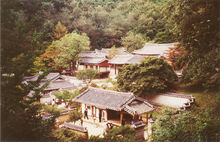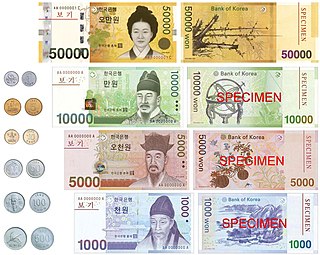
The South Korean won, officially the Korean Republic won is the official currency of South Korea. A single won is divided into 100 jeon, the monetary subunit. The jeon is no longer used for everyday transactions, and it appears only in foreign exchange rates. The currency is issued by the Bank of Korea, based in the capital city of Seoul.

Neo-Confucianism is a moral, ethical, and metaphysical Chinese philosophy influenced by Confucianism, and originated with Han Yu (768–824) and Li Ao (772–841) in the Tang Dynasty, and became prominent during the Song and Ming dynasties under the formulations of Zhu Xi (1130–1200). After the Mongol conquest of China in the thirteenth century, Chinese scholars and officials restored and preserved neo-Confucianism as a way to safeguard the cultural heritage of China.
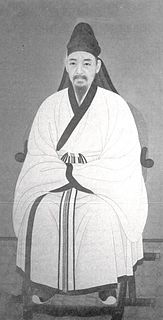
Yi Yi was a Korean philosopher, writer, and Confucian scholar of the Joseon Dynasty. Yi I is often referred to by his pen name Yulgok. He was also a politician and was the academical successor of Jo Gwang-jo.

Yi Hwang was the most important Korean philosopher, writer, and Confucian scholar of the Joseon Dynasty. He was a figure of the Neo-Confucian literati, established the Yeongnam School and set up the Dosan Seowon, a private Confucian academy.

Changdeokgung, also known as Changdeokgung Palace or Changdeok Palace, is set within a large park in Jongno District, Seoul, South Korea. It is one of the "Five Grand Palaces" built by the kings of the Joseon Dynasty (1392–1897). As it is located east of Gyeongbok Palace, Changdeokgung—along with Changgyeonggung—is also referred to as the "East Palace".

Andong is a city in South Korea, and the capital of North Gyeongsang Province. It is the largest city in the northern part of the province with a population of 167,821 as of October 2010. The Nakdong River flows through the city. Andong is a market centre for the surrounding agricultural areas.

Korean philosophy focused on a totality of world view. Some aspects of Shamanism, Buddhism, and Neo-Confucianism were integrated into Korean philosophy. Traditional Korean thought has been influenced by a number of religious and philosophical thought-systems over the years. As the main influences on life in Korea, often Korean Shamanism, Korean Taoism, Korean Buddhism, Korean Confucianism and Silhak movements have shaped Korean life and thought. From 20th century, various Western philosophical thoughts have strongly influenced on Korean academia, politics, and daily life.
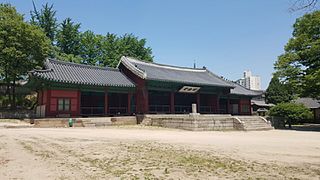
Sungkyunkwan was the foremost educational institution in Korea during the late Goryeo and Joseon Dynasties. Today, it sits in its original location, at the south end of the Humanities and Social Sciences Campus of Sungkyunkwan University in Seoul, South Korea. Twice a year, in May and September, the ceremonial rite Seokjeon Daeje is performed in the Munmyo Shrine, to honor Confucius and the Confucian sages of China and Korea.

Seowon were the most common educational institutions of Korea during the mid- to late Joseon Dynasty. They were private institutions, and combined the functions of a Confucian shrine and a preparatory school. In educational terms, the seowon were primarily occupied with preparing students for the national civil service examinations. In most cases, seowon served only pupils of the aristocratic yangban class. On 6 July 2019, UNESCO recognized a collection of nine seowon as a World Heritage Site.
The Sarim, or "forest of scholars", was a powerful faction of literati that dominated Middle and Late Joseon politics in Korea.
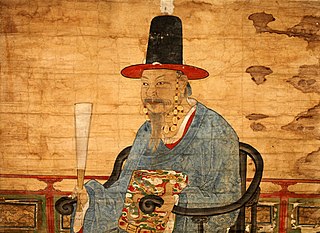
Seonjo of Joseon was the fourteenth king of the Joseon Dynasty of Korea from 1567 to 1608. He was known for encouraging Confucianism and renovating state affairs at the beginning of his reign. However, political discord and incompetent leadership during the Japanese invasions of Korea marred his later years.
The Bungdang refers to political factionalism that was characteristic of middle and late Joseon dynasty. Throughout the dynasty, various regional and ideological factions struggled for dominance in the political system. Village Seowon, which combined the functions of Confucian shrines with educational institutions, often reflected the factional alignment of the local elite.

Sosu Seowon is the oldest seowon, private Neo-Confucian academy in Korea which was established during the Joseon Dynasty period. It was found at the entrance of Suksusa Temple, in Sunheung-myeon, Yeongju City, Gyeongsangbuk-do South Korea. Sosu Seowon was founded by Ju Sebung, who was serving as magistrate of Pungseong county.
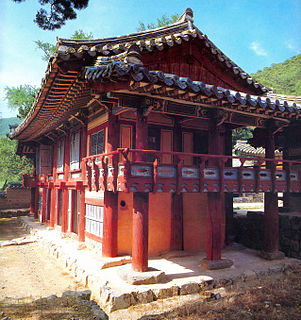
The Oksan Seowon is a seowon located at Oksan-ri, Angang-eup in the city of Gyeongju, North Gyeongsang Province, South Korea. Seowon is a type of local academy during the Joseon Dynasty (1392–1897). It was established by Yi Je-min, (李齊閔), the minister of Gyeongju and local Confucian scholars in 1572, the fifth year of King Seonjo's reign, to commemorate the scholarly achievement and virtue of Confucian scholar and politician Yi Eon-jeok (1491–1553).

The Byeongsan Seowon is a seowon located in Byeongsa-ri village of the Pungcheon-myeon township in the city of Andong, North Gyeongsang Province, South Korea. Seowon is a type of local academy during the Joseon Dynasty (1392–1897). It was first established as Jondeoksa (尊德祠) by local Confucian scholars especially Jeong Gyeong-se (鄭經世) in 1613, the fifth year of King Gwanghaegung's reign, to commemorate the scholarly achievement and virtue of the notable Confucian scholar and politician Ryu Seong-ryong. The predecessor of the seowon was Pungak Seodang (豊岳書堂) which was a school located in Pungsan to teach the Pungsan Ryu clan during the Goryeo period. Ryu Seong-ryong moved the seodang to the current place in 1572.

The Imcheon Seowon is a seowon located in the neighborhood of Songhyeon-dong of Andong, North Gyeongsang Province, South Korea. Seowon is a type of local academy during the Joseon Dynasty (1392–1897). It was first established by local Confucian scholars in 1607, the 40th year of King Seonjo's reign, to commemorate the scholarly achievement and virtue of the Confucian scholar and politician Kim Seong-il.
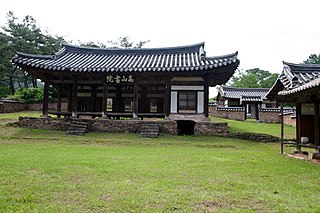
The Gosan Seowon is a seowon located in the village of Gwangeum-ri, Namhu-myeon of Andong, North Gyeongsang Province, South Korea. Seowon is a type of local academy during the Joseon Dynasty (1392–1897). It was first established by local Confucian scholars in 1789, the 13th year of King Jeongjo's reign, to commemorate the scholarly achievement and virtue of the Confucian scholar Yi Sang-jeong.
Jeong Gu (1543–1620), also spelled as Jung Goo, was a Korean historian, philosopher, poet, and politician of the Joseon period. He learned from the Korean scholars Yi Hwang and Cho Shik. A key figure of the Neo-Confucian literati, he established the Yeongnam School and set up the Baikmaewon(백매원, 百梅園), a private Confucian academy. His pen name was Hangang(한강, 寒岡)·Hoiyunyain(회연야인, 檜淵野人), and courtesy name was Doga(도가, 道可) and Gabo(가보, 可父).

The Easterners were a political faction of the Joseon dynasty. This faction appeared during the reign of Seonjo of Joseon in sixteenth-century Korea. Originating from friends of Gim Hyowon, they soon encompassed most of the disciples of Jo Sik and Yi Hwang, conflicting with Yi I and his followers, who formed the core of the Westerners. Though emerging as the dominant faction in the 1580s, it nearly collapsed at the suicide of Jeong Yeorip and the succeeding bloodshed in 1589. After Westerner Jeong Cheol was exiled for attempting to make Prince Gwanghae the Crown Prince, the Easterners divided into Northerners and Southerners.
U Tak, also known as Woo Tak, was a Korean Neo-Confucian scholar and philosopher during Korea’s Goryeo dynasty. He was also commonly known as Yeokdong Seonsaeng. His pen names were Baekun and Danam, his courtesy names were Cheonjang and Takbo, and his posthumous name was Moonhee. U Tak helped spread Neo-Confucianism, which had come from the Yuan dynasty, in Korea. He was a disciple of the Neo-Confucian scholar, An Hyang.
